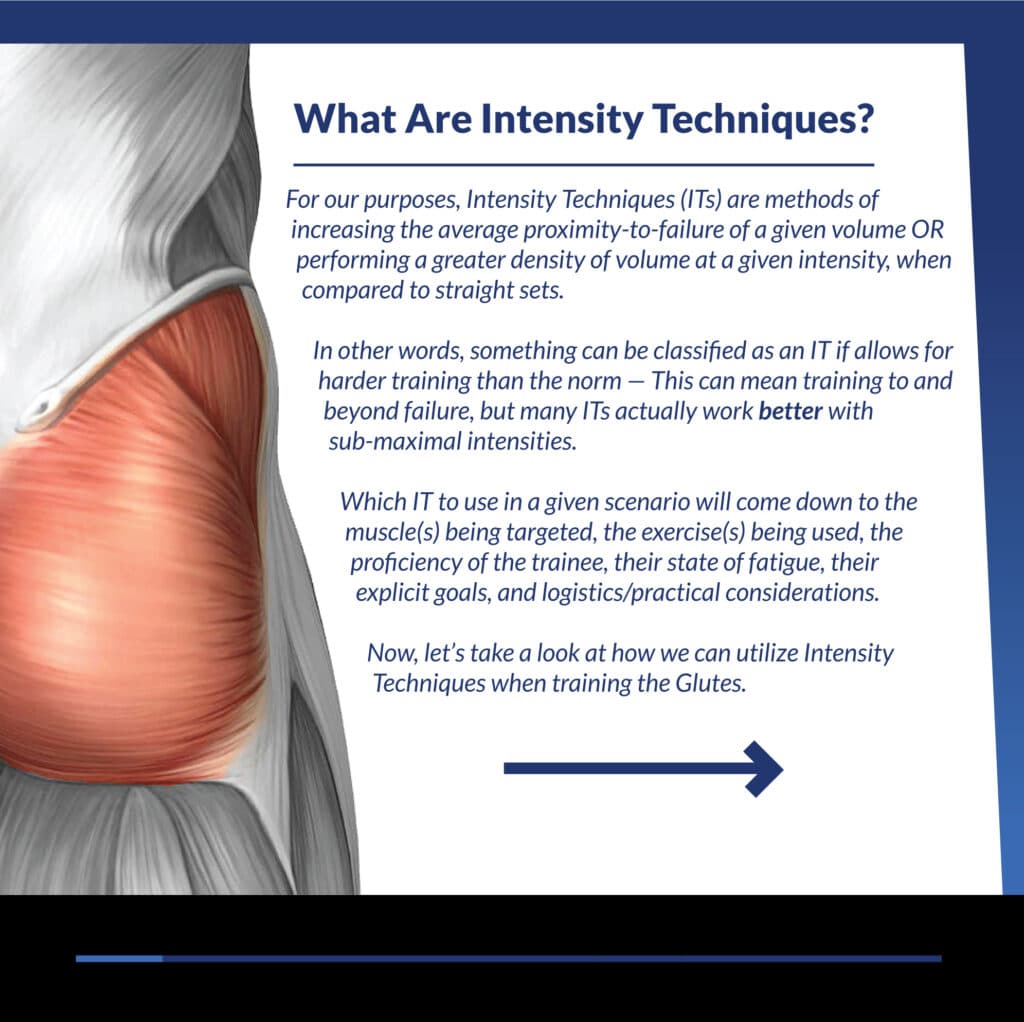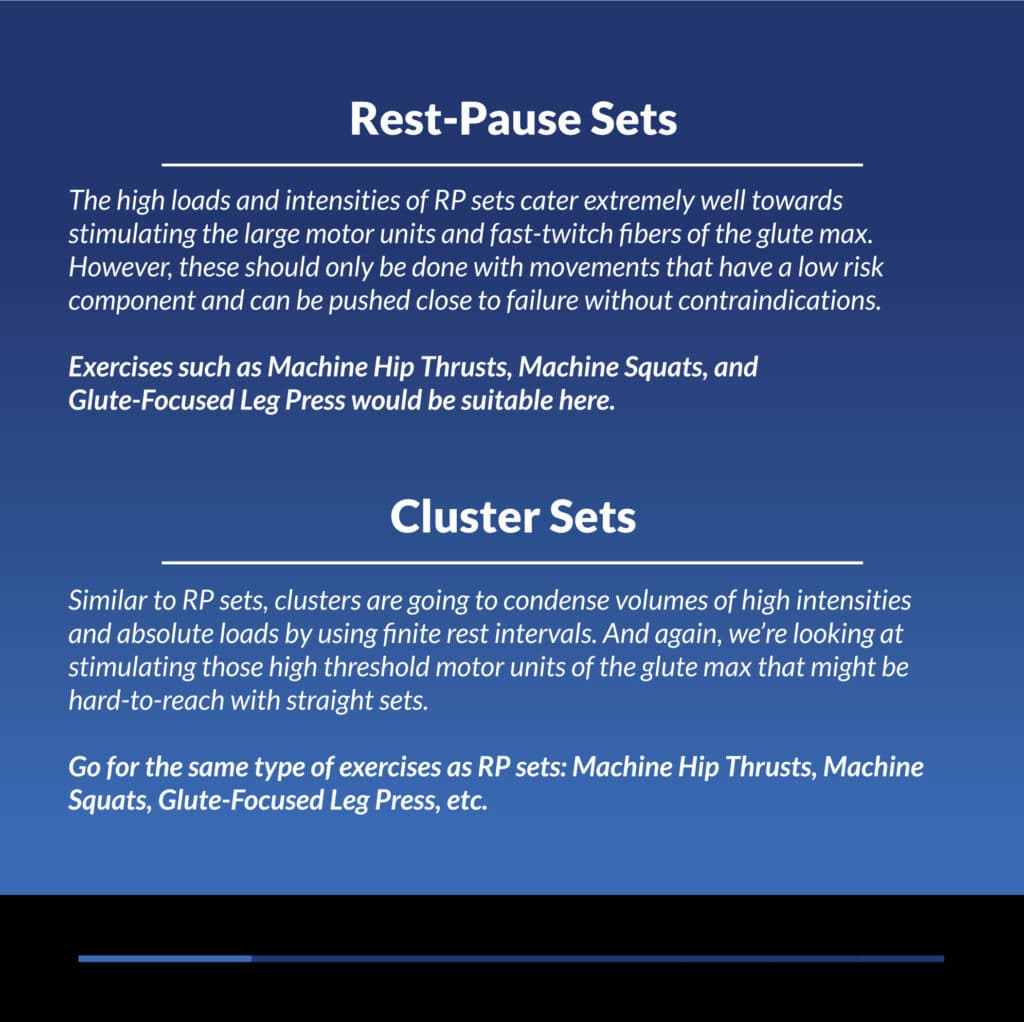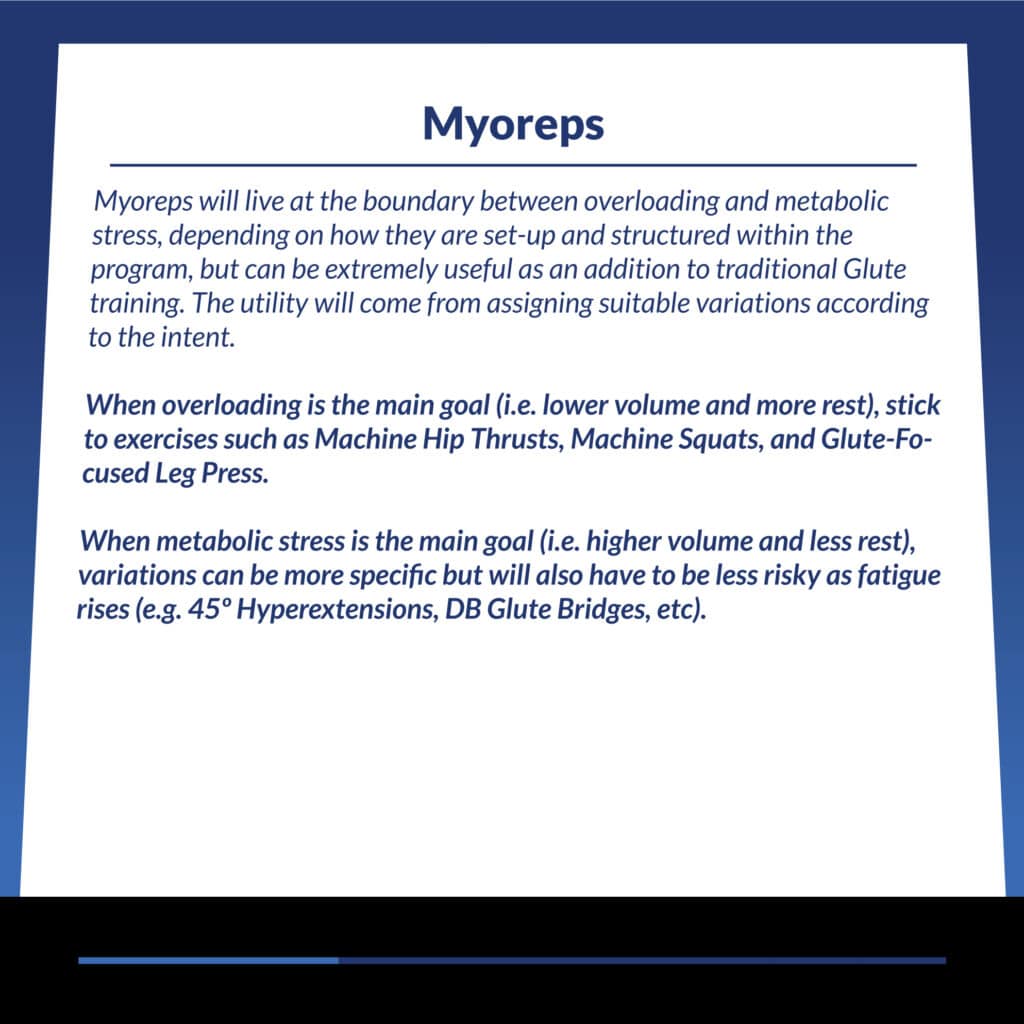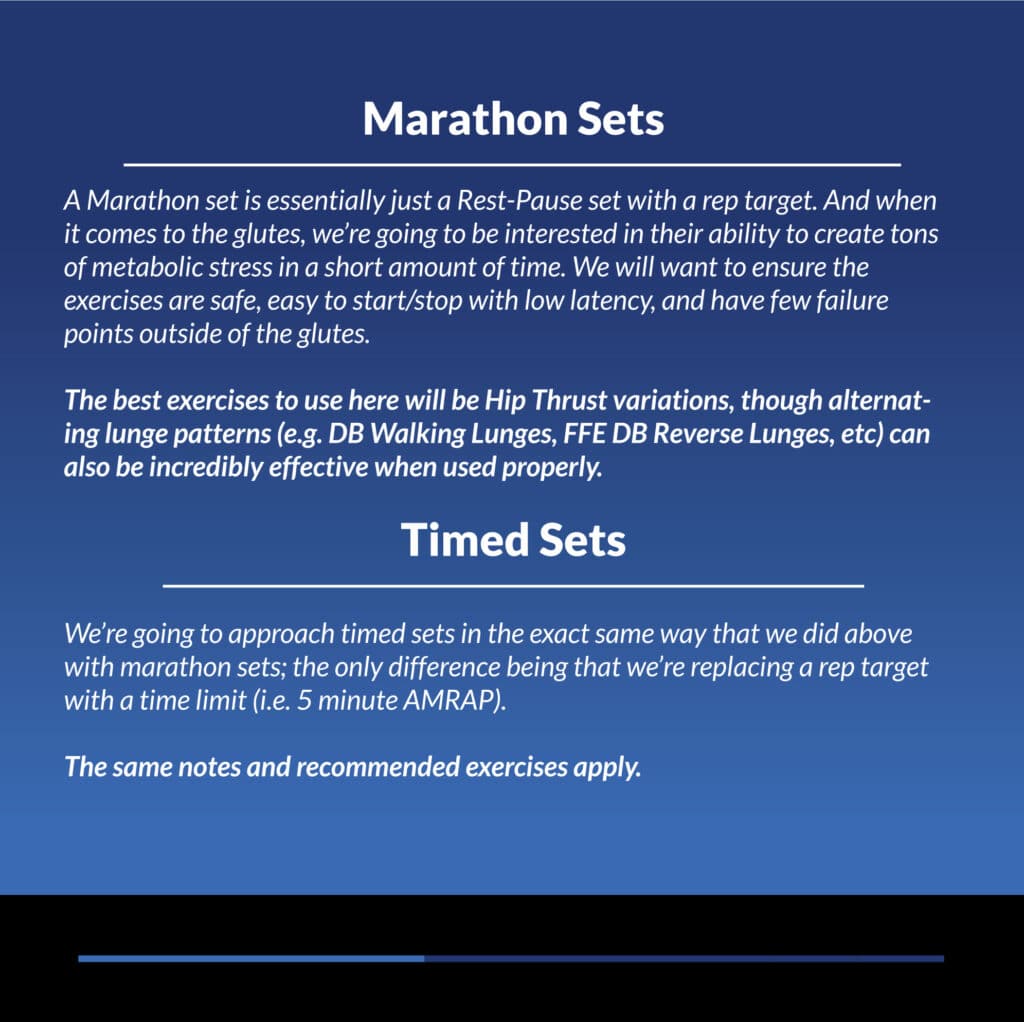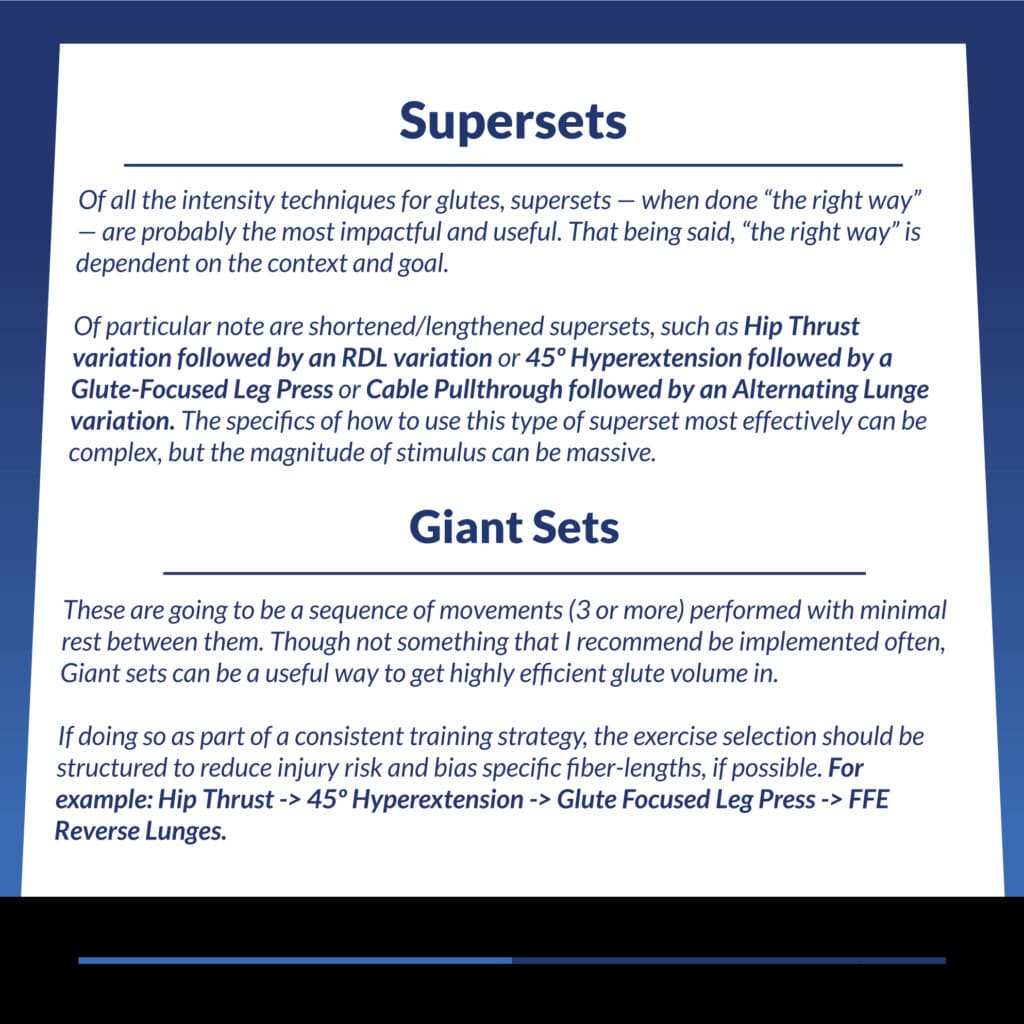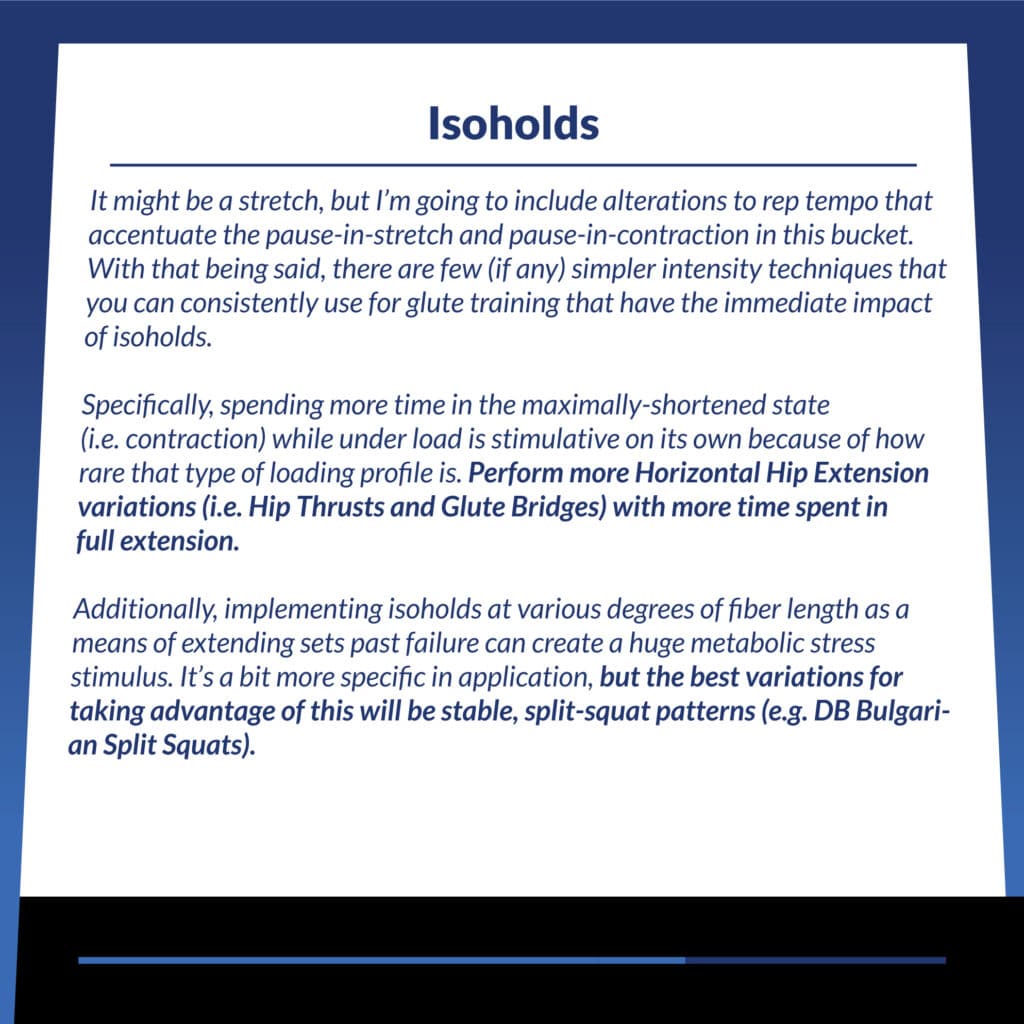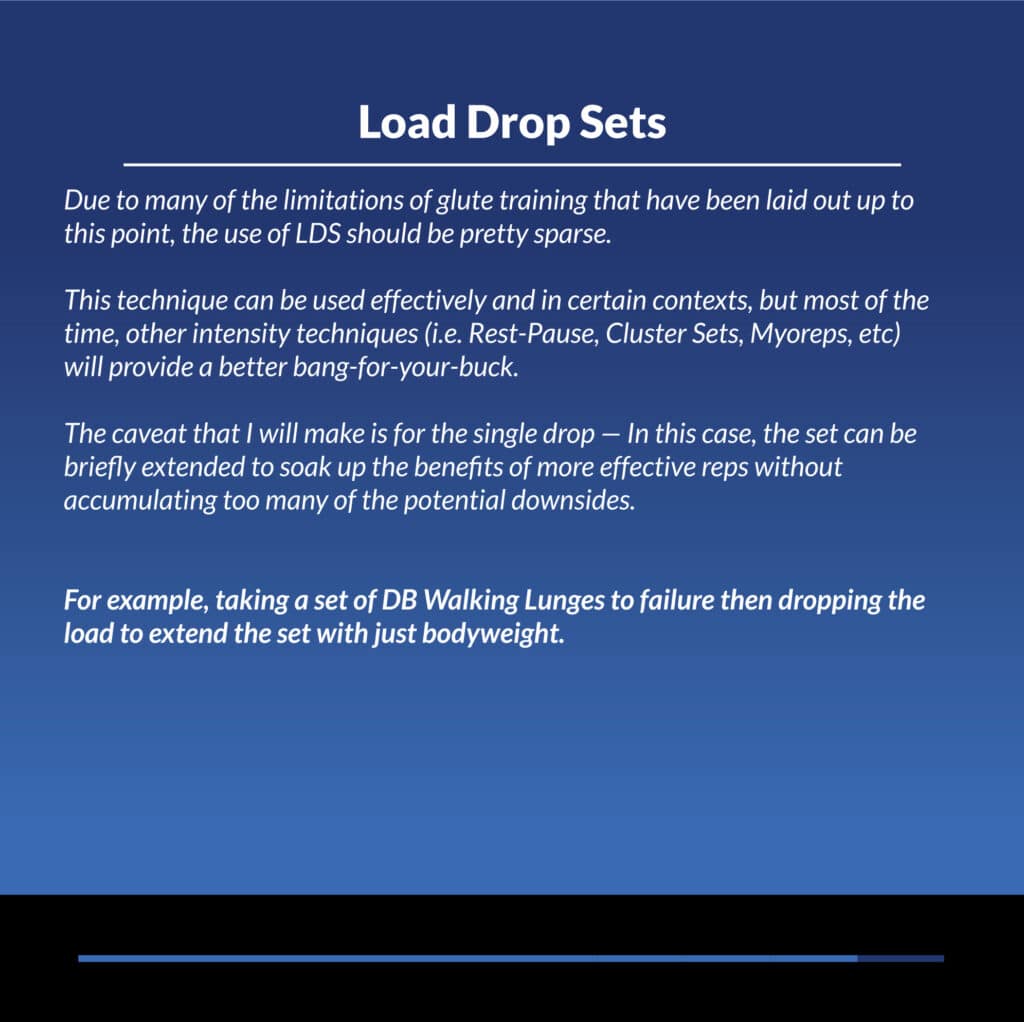What Are Intensity Techniques?
For our purposes, Intensity Techniques (ITs) are methods of increasing the average proximity-to-failure of a given volume OR performing a greater density of volume at a given intensity, when compared to straight sets.
In other words, something can be classified as an IT if allows for harder training than the norm – This can mean training to and beyond failure, but many ITs actually work better with sub-maximal intensities.
Which IT to use in a given scenario will come down to the muscle(s) being targeted, the exercise(s) being used, the proficiency of the trainee, their state of fatigue, their explicit goals, and logistics/practical considerations.
Now, let’s take a look at how we can utilize Intensity Techniques when training the Glutes…
Rest-Pause Sets– The high loads and intensities of Rest-Pause sets cater extremely well towards stimulating the large motor units and fast-twitch fibers of the glute max. However, these should only be done with movements that have a low risk component and can be pushed close to failure without contraindications. Exercises such as Machine Hip Thrusts, Machine Squats, and Glute-Focused Leg Press would be suitable here.
Cluster Sets– Similar to RP sets, clusters are going to condense volumes of high intensities and absolute loads by using finite rest intervals. And again, we’re looking at stimulating those high threshold motor units of the glute max that might be hard-to-reach with straight sets. Exercises such as Machine Hip Thrusts, Machine Squats, and Glute-Focused Leg Press would be suitable here.
Myoreps– Myoreps will live at the boundary between overloading and metabolic stress, depending on how they are setup and structured within the program. This will necessitate viewing the suitable variations slightly differently based off the intent. When overloading is the main goal (i.e. lower volume and more rest), stick to exercises such as Machine Hip Thrusts, Machine Squats, and Glute-Focused Leg Press. When metabolic stress is the main goal (i.e. higher volume and less rest), variations can be more specific but will also have to be less risky as fatigue rises (e.g. 45º Hyperextensions, DB Glute Bridges, etc).
Marathon Sets– In this context, a marathon set is essentially just a Rest-Pause set with a rep target. And when it comes to the glutes, we’re going to be interested in marathon sets’ ability to induce massive metabolic stress with high density. We will want to ensure the exercises are safe, easy to start/stop with low latency, and have few failure points outside of the glutes. The best exercises to use here will be Hip Thrust variations, though alternating lunge patterns (e.g. DB Walking Lunges, FFE DB Reverse Lunges, etc) can also be incredibly effective when used properly.
Timed Sets– We’re going to approach timed sets in the exact same way that we did above with marathon sets; the only difference being that we’re replacing a rep target with a temporal one (i.e. 5 minute AMRAP). The same notes apply.
Supersets– Of all the intensity techniques for glutes, supersets (when done the right way) are probably the most impactful. That being said, there are plenty of ways to perform glute supersets “the right way” depending on the context and goal. Of particular note is that of shortened/lengthened supersets, such as a Hip Thrust variation followed by an RDL variation, or a 45º Hyperextension followed by a Glute-Focused Leg Press, or a Cable Pullthrough followed by an alternating Lunge variation. The specifics of how to do this effectively is beyond the scope of this section, but the magnitude of stimulus created from this type of sequence is massive.
Giant Sets– These are going to be a sequence of movements (3 or more) performed with minimal rest between them. Though not something that I imply often, Giant sets can easily be performed for the glutes with high efficacy. If doing so as part of a consistent training strategy, I would recommend that the exercise selection bias specific fiber lengths if possible. For example: Hip Thrust -> 45º Hyperextension -> Glute Focused Leg Press -> FFE Reverse Lunges
Pre-Exhaustion– Similar to the shortened/lengthened supersets above, the hypertrophic effect with pre-exhaustion is going to come down to nailing the exercises used and the parameters around them. The best case for pre-exhausting the glutes comes from the inherent challenges with ensuring that ancillary muscle groups are not monopolizing the effective reps. What I mean by this is that, most of the time, the failure point of a movement isn’t going to be the glutes but one of the other working muscles (i.e. quads in a squat, hamstrings in a hinge, etc) or even an extrinsic variable (e.g. grip strength, cardiovascular fitness, poor intra-abdominal bracing, etc). And pre-exhausting the glutes with a targeted exercise before going into this hypothetically-limited exercise can close the gap between the glutes’ failure point and the “true” failure point.
Pre-exhaustion can also be implemented on a higher-level (specifically, in the structure of the session so that the order of exercises goes from isolated/light -> compound/heavy), but we won’t focus on this level here. Also note that pre-exhaustion can actually have the opposite effect of limiting the total stimulus received by the glutes if implemented incorrectly or without a strategy.
Isoholds– Maybe it’s a stretch, but I’m going to include alterations to rep tempo that accentuate the pause-in-stretch and pause-in-contraction in the isohold bucket. And with that being said, there are few (if any) simpler intensity techniques that you can consistently use for glute training that have the impact of isoholds. Specifically, spending more time in the maximally-shortened state (i.e. contraction) while under meaningful load is hypertrophically stimulating on its own due to the novelty of that type of tension outside of horizontal hip extension variations (i.e. Hip Thrusts and Glute Bridges). Additionally, implementing isoholds at various degrees of fiber length as a means of extending sets past failure can create a huge metabolic stress stimulus. It’s a bit more specific in application, but the best variations for taking advantage of this will be stable, split-squat patterns (e.g. DB Bulgarian Split Squats).
Load Drop Sets– Due to many of the limitations of glute training that have been laid out up to this point, the use of load drop sets will be pretty sparse. This technique can be used effectively and in certain contexts, but most of the time, other intensity techniques (i.e. rest pause, clusters, myoreps, etc) will provide a better bang-for-your-buck. The caveat that I will make is for the single drop—in this case, the set can be briefly extended to soak up the benefits of more effective reps but without accumulating too many of the potential downsides. For example, taking a set of DB Walking Lunges to failure then dropping the load to extend the set with just bodyweight.

